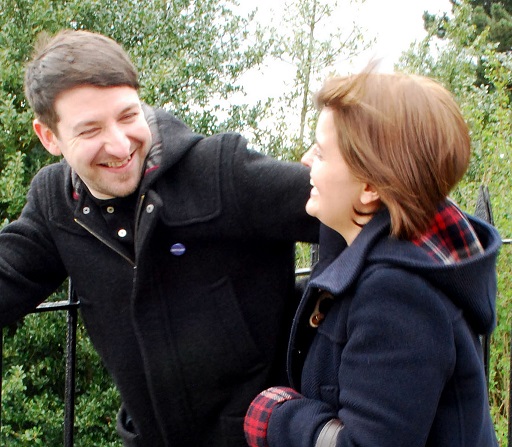Is a funny pick-up line a good idea, or will it hurt your chances? The role of humor in courtship is a fascinating puzzle that is beginning to receive empirical attention. The current article provides a glimpse at when and why humor might be useful during romantic relationship initiation, and explains how your humor style might affect your success in attracting a potential romantic partner.
If you were to list all the attractive qualities that you might look for in a potential romantic partner, chances are that a “good sense of humor” would rank high on your list. Someone who makes you laugh, tells a good joke, giggles at your one-liners … these attributes seem to have near universal appeal. Indeed, a good sense of humor is perceived as highly attractive (Lippa, 2007), ranking as the number one most effective tactic for appealing to the opposite sex (Buss, 1988). Given its pervasive desirability, have you ever wondered why people are attracted to humor? And further, in the confusing whirlwind of match making, how do people most effectively showcase their humor? The following article uses current research to help unravel the puzzle of humor in romantic relationship initiation.
On the surface, humor seems like a superficial part of a first conversation. Jokes or witty banter are not typically rich with get-to-know-you information and often relate only tangentially to a topic under discussion, if at all. Yet, humor is consistently identified as an important quality in potential romantic partners. Humor is attractive not only in the United States (Sprecher & Regan, 2002) but in cultures all over the world (Hatfield & Sprecher, 1995; Lippa, 2007). Laboratory studies echo self-reported preferences, showing that people rate humorous hypothetical dating prospects more favorably than less humorous candidates (McGee & Shevlin, 2009). Particularly convincing is evidence from experimental field studies, such as one demonstrating that women are more likely to give their phone numbers to men who tell funny jokes than those who do not (Guéguen, 2010). Still, we all know that humor sometimes falls flat, creating more of an awkward situation than perfect moment. Evidence also supports this observation, with humor at times registering as an ineffective and inappropriate flirting strategy (Weber, Goodboy, & Cayanus, 2010). So which is it? Does humor help or hurt relationship initiation? To help avert a flirting disaster and to grow in our understanding of social dynamics, we can take a closer look at the role humor plays in romantic attraction, uncovering not only when but also why humor may facilitate a love connection.
Humor from the Sexual-Selection Perspective
Some evolutionary theorists suggest that humor may have evolved specifically to support successful dating decisions, or in evolutionary terms, mating decisions. This perspective begins by recognizing humor as a puzzling characteristic. Being funny differs from traits like social dominance, wealth, or physical attractiveness, preferences for which can be explained for their direct evolutionary benefits (Buss & Schmitt, 1993; Sadalla, Kenrick, & Vershure, 1987). A socially-dominant, wealthy man can provide resources for his family, enhancing his and their survival. Likewise, a woman’s physically attractiveness signals her health and fertility, which promote successful reproduction (Buss & Schmitt, 1993). Humor, however, bears no direct influence on survival. Up against this mystery, researchers looked more deeply into the experience of humor and what it might reveal in social interactions.
Hard-to-Fake Humor
Think for a moment about your funniest friend. Could you easily imitate his or her witty comebacks or hilarious stories? Probably not. Humor is often incredibly difficult to imitate, a characteristic that suggests it might reliably signal underlying fitness (Miller 2000a; 2000b). By fitness, scholars mean the quality of individuals’ heritable traits, including genes, physical health, and psychological functioning (Andersson, 1994). People try to select romantic partners with maximal fitness so that they (and any future offspring) can benefit from their partner’s top-notch genetic qualities.
To reliably signal fitness, humor must be difficult to imitate. Unlike memorized jokes, difficult-to-fake humor involves creativity, spontaneity, and a keen awareness of social timing and interpersonal dynamics. When humor is more rudimentary, its effects are less impressive. Unrefined opening gambits that sound like memorized jokes keep conversations going less well than spontaneous wit (Bale, Morrison, & Caryl, 2006). Contradictory evidence suggests that sophomoric humor (e.g., “Birthday cake is the only food you can blow on and spit on and everybody rushes to get a piece,” p. 32) can still produce romantic interest, despite implying unfavorable underlying qualities (Bressler & Balshine, 2006). This finding, however, should be interpreted cautiously because the study did not distinguish between short-term or long-term affairs. When a relationship-length distinction is made, people who offer flippant pick-up lines might be tolerable for the short-term, but not the long-term (Senko & Fyffe, 2010). For long-term relationships, high-quality humor, the kind that is spontaneous and difficult to fake, outperforms unsophisticated humor perhaps because the former conveys underlying intelligence (Miller, 2000a; 2000b).
Humor as a Cue for Intelligence
Both men and women desire intelligent partners (Lippa, 2007) and intelligence translates to advantages in resource acquisition, social interactions, genes, child-rearing, and co-parenting (Lippa, 2007; Miller, 2000a; 2000b). These outcomes enhance survival, explaining the appeal of intelligence from an evolutionary perspective. If humor can reliably signal intelligence, then humor might itself be attractive during relationship initiation. This fits nicely into sexual selection theory (Miller 2000a; 2000b): over time, displaying humor to communicate intelligence may have proved reproductively beneficial, rendering humor an established courtship behavior in today’s mating game.
Evidence connecting humor with intelligence supports the evolutionary hypothesis that humor developed to indicate fitness. Humor production correlates with intelligence in numerous cultures (Weisfeld et al., 2011) and twin studies suggest a shared genetic basis for humor styles and emotional intelligence (Vernon et al., 2009). People who can draw funnier pictures and tell funnier stories tend to be more intelligent (Howrigan & MacDonald, 2008), and people’s abstract reasoning skills and verbal intelligence can predict how effectively they produce funny captions to unlabeled cartoons (Greengross & Miller, 2011). Interestingly, people’s ability to generate humor corresponds with their reported number of short-term dating partners (Greengross & Miller, 2011). In other words, those who can showcase their intellect through humor are having more sexual liaisons, presumably in part because their humor renders them more attractive.
Gender Differences in Humor
We now know that certain types of humor might tell us about underlying intelligence better than others, but if humor really evolved as a fitness indicator, Miller (2000a; 2000b) argued that we should see gender differences in humor use during relationship initiation. This assumption is based on a classic feature of sexual selection theory referred to as differential parental investment, which contends that females risk more than males in any sexual interaction because their potential costs incurred are greater (Trivers, 1972). These costs are linked to biologically-based differences in the minimum investment required for males (e.g., copulation) and females (e.g., a 9-month gestation period, generally followed by months or years of breast-feeding) for a given offspring to survive. Females also have fewer chances than males to reproduce because of their brief fertile window and limited number of eggs (compared to trillions of sperm). With so much more at stake, women are apt to be particularly choosy in the partners they select (Kenrick, Groth, Trost, & Sadalla, 1993).
Gender differences in humor may arise from the fact that females are highly selective. Female selectivity puts the burden on men to vigorously advertise their viability as partners, i.e., males may need to showcase their fitness to attract female attention. Accordingly, men tend to display and brag about their resources more than women (Buss, 1988). They might derogate a rival, engage in self-promotion, or conspicuously spend money (Fisher & Cox, 2011; Griskevicius et al., 2007). Men may also showcase their fitness through humor, and if so, we should anticipate a gender difference in humor during flirtation (Miller, 2000b).
Does a gender difference in humor ring true with your own experiences? Have you ever noticed men making women laugh, while women are doing the laughing? Scientific support for this gender difference is accumulating. Husbands in China, Turkey, the United Kingdom, and the United States tend to make their wives laugh more than their wives make them laugh, although wives are the leading comedians in Russia (Weisfeld et al., 2011). In the U.S., men tend to value women’s receptivity to their own humor over women’s attempts to be funny, while women view both humor receptivity and production as important (Bressler, Martin, & Balshine, 2006). Further, women like men who produce humor, while men seem impartial to humorous women (Bressler & Balshine, 2006). Perhaps humor production is a way for men, more than women, to display their underlying positive qualities during courtship.
Humor Production vs. Humor Appreciation
In a particularly convincing set of studies, Wilbur and Campbell (2011) offered support for humor as a fitness indicator during relationship initiation. They first demonstrated that men report producing humor more than women during relationship initiation, while women reported appreciating and evaluating humor more than men. An analysis of online dating profiles supported these gender differences: men tended to offer humor production (e.g., self-describing as “witty” or an “aspiring stand-up comic”; p. 923), while women indicated they wanted a humor producer (e.g., someone who “can make me laugh”; p. 923). In their final study, Wilbur and Campbell (2011) asked participants about their potential romantic interest in a person depicted in a hypothetical online dating profile. Consistent with sexual selection theory and humor as a fitness indicator, women who rated the person as funnier also tended to find him more attractive, whereas this pattern did not emerge for men. Women’s humor ratings corresponded with inferences of intelligence as well as warmth, a characteristic linked to sharing resources and co-parenting skill (Miller, 2007). In sum, Wilbur and Campbell’s (2011) research offers compelling evidence that humor’s privileged place in flirtatious interactions may stem from its ability to signal underlying fitness.

Alternative Perspectives on Humor
The fitness-indicator model offers one fascinating explanation for humor, but other key perspectives are also worth our attention. Some evolutionary theorists contend that humor evolved to promote social bonding, in dating and in other social context (Storey, 2003). Indeed, for potential friends and romantic partners alike, engaging in a humorous interaction, such as playing a silly game of charades, induces feelings of liking and closeness (Treger, Sprecher, & Erber, 2013). Perhaps humor is a desirable mate characteristic simply because it increases the enjoyment of a social interaction. After all, at least in Western culture, both gay and straight individuals value playful and fun romantic partners (Morgan, Richards, VanNess, 2010).
Taking a slightly different approach, humor’s purpose may be to communicate interest (Li et al., 2009). Unlike the sexual-selection approach, this interest-indicator model suggests humor follows (rather than precedes) romantic attraction, but, like the social bonding perspective (Treger et al., 2013) still allows for a reciprocal relation between humor and liking.
Although different, these three perspectives are certainly compatible. In the mating game, humor may signal underlying positive traits while also communicating interest and increasing the pleasantness of a conversation. Both the interest indicator model (Li et al., 2009) and the social bonding explanation (Storey, 2003) also pick up where the sexual-selection model leaves off, suggesting that people use humor to begin and maintain not only romantic, but also friend, family, and work relationships.
How to Use Humor in Relationship Initiation
Given its potentially important role in relationship initiation, how do people communicate their humor to attractive others? Martin and colleagues (2003) suggest that there are four styles of humor that people tend to adopt in everyday life. The first two, affiliative and self-enhancing, are positive humor styles. Affiliative humor is an amusing, friendly, inviting humor style, while self-enhancing humor reflects a tendency to take a humorous view of life, even in difficult times. The other two styles, considered negative humor styles, are aggressive humor and self-defeating humor. The former evokes laughter through sarcasm, ridicule, or hurtful teasing, while the latter produces laughter at the expense of the self. Positive humor styles tend to be associated with psychological well-being, self-esteem, and social intimacy, while the negative humor styles are linked with more hostility and aggression (Martin et al., 2003). How might these styles relate to relationship initiation success?
The Effectiveness of Different Humor Styles
In order to ask this question, DiDonato and colleagues (2013) generated a series of funny hypothetical first encounters with an attractive stranger. Participants were asked to imagine that they were approached by a stranger while sitting at a bar. They then read a conversation in which the stranger produced either affiliative humor (i.e., positive humor) or aggressive humor (i.e., negative humor). How would you evaluate a stranger who sees you sit down and then says, “That seat is for good looking people only…do you think you’ll do?” The stranger might be joking, but what impression did the joke give you? Participants then rated this stranger on attractiveness for a short-term or a long-term romantic relationship, and judged the stranger’s competence and warmth, allowing the researchers to compare reactions to the different humor styles.
The findings showed that humor style influenced flirting success, even after accounting for funniness. Both men and women preferred the stranger who used positive (vs. negative) humor (DiDonato et al., 2013). Funny quips about a bartender’s peanut offerings apparently outperformed sarcastic, aggressive teasing; but, interestingly, this difference was only relevant when participants considered long-term relationships. Humor style made no difference when participants evaluated prospects for short-term encounters, which is consistent with evidence that cheesy pick-up lines (e.g., “Do you have any raisins? No? Well then, how about a date?” p. 653) are just as effective as more sincere overtures when initiating short-term relationships (Senko & Fyffe, 2010). Findings also showed that positive humor conveyed more competence (which encompasses intelligence) and warmth than negative humor, and these underlying inferences helped account for the connection between humor style and long-term relationship interest (DiDonato et al., 2013). Taken together, these findings advance the idea that humor operates as a fitness indicator, suggesting that humor style, not just humor alone, signals specific underlying characteristics.
Some Practical Considerations
Where does this leave us? Well, it seems that initiating some amusing banter, especially for men, may be a great way to charm a potential romantic partner, either by signaling appealing partner qualities (Wilbur & Campbell, 2011), revealing interest (Li et al., 2009), or creating cohesion (Storey, 2003). Before you try to dazzle people with your wit, however, a couple points of caution. If you are looking for long-term love, take stock of your other attractive qualities first. Some evidence suggests that humor will help your chances only when you are already physically attractive (Lundy, Tan, & Cunningham, 1998). Initial status may also matter: high-status people can increase their attractiveness using self-deprecating humor, but this will not necessarily work for low-status people (Greengross & Miller, 2008). Consider also your prospect’s energy level, as people who are ego-depleted tend to be less receptive to cute opening gambits (e.g., “Excuse me what time is it? I just wanted to be able to remember the exact moment that I met you’’ p. 1076) than people who have plenty of self-control (Lewandowski, Ciarocco, Pettenato, & Stephan, 2012). Finally, people who stay together tend to share humor styles (Barelds & Barelds-Dijkstra, 2010), suggesting that if you use humor as a coping mechanism and your prospective partner does not, you may have trouble beyond a short-term relationship.
The success of humor, like many interpersonal behaviors, may depend in part on contextual factors and individuals’ goals, so the savvy comedian will need to read these carefully before offering a quick-witted comment. In general, err on the side of positive humor (DiDonato et al., 2013), such as spontaneous, warm humor that builds off of shared experiences, the surroundings, or everyday news or events. For example, if a cute passerby spills a drink, resist the urge to sarcastically poke fun (e.g., “Remind me never to wear nice clothes around you”) and instead, relax, smile, and create a connection (e.g., “I agree – this floor needs a good cleaning”). The good news is that failed humor may still leave the door open for a short-term affair, but keep in mind that prospective long-term partners are discerning, using whatever clues they can to navigate the uncertain process of finding a good partner.
As a final recommendation, if humorous remarks are not your forte, you might be wise to pursue an alternative flirting strategy, at least initially. Better to think long-term and allow your other strengths to shine than to offer a line that is canned or, worse, not actually funny. One explanation for why humor sometimes fails as a relationship starter is that sometimes an intended humorous comment leaves no one laughing (Bale et al., 2006; Weber et al., 2010). Even if the right kind of humor can be a quick, effective, and pleasurable strategy for conveying a wealth of positive mate characteristics, direct approaches or compliments are preferable to weak humor (Senko & Fyffe, 2010). Remember too that people will find you funnier if they are already attracted to you (Li et al., 2009), an important detail to keep in mind as you think about how humor can best fit into your toolbox of flirting tactics.
References
Andersson, M. B. (1994). Sexual selection. Princeton, New Jersey: Princeton University Press.
Bale, C., Morrison, R., & Caryl, P. G. (2006). Chat-up lines as male sexual displays. Personality and Individual Differences, 40, 655-664.
Barelds, D. P., & Barelds-Dijkstra, P. (2010). Humor in intimate relationships: Ties among sense of humor, similarity in humor and relationship quality. Humor-International Journal of Humor Research, 23, 447-465.
Bressler, E. R. & Balshine, S. (2006). The influence of humor on desirability. Evolution and Human Behavior, 27, 29-39.
Bressler, E.R., Martin, R., & Balshine, S. (2006). Production and appreciation of humor as sexually selected traits. Evolution & Human Behavior, 27, 121-130.
Buss, D. M. (1988). The evolution of human intrasexual competition: tactics of mate attraction. Journal of Personality and Social Psychology, 54, 616-628.
Buss, D. M., & Schmitt, D. P. (1993). Sexual strategies theory: An evolutionary perspective on human mating. Psychological Review, 100, 204-204.
DiDonato, T. E., Bedminster, M. C. & Machel, J. J. (2013). My funny valentine: How humor styles affect romantic interest. Personal Relationships, 20, 374-390.
Fisher, M., & Cox, A. (2011). Four strategies used during intrasexual competition for mates. Personal Relationships, 18, 20-38.
Greengross, G., & Miller, G. F. (2008). Dissing oneself versus dissing rivals: Effects of status, personality, and sex on the short-term and long-term attractiveness of self-deprecating and other-deprecating humor. Evolutionary Psychology, 6, 393-408.
Greengross, G. & Miller, G. (2011). Humor ability reveals intelligence, predicts mating success, and is higher in males. Intelligence, 39, 188-192. doi:10.1016/j.intell.2011.03.006
Griskevicius, V., Tybur, J. M., Sundie, J. M., Cialdini, R. B., Miller, G. F., & Kenrick, D. T. (2007). Blatant benevolence and conspicuous consumption: when romantic motives elicit strategic costly signals. Journal of personality and social psychology, 93, 85-102.
Guégen, N. (2010). Men’s sense of humor and women’s responses to courtship solicitations: An experimental field study. Psychological Reports, 107(1), 145-156.
Hatfield, E., & Sprecher, S. (1995). Men's and women's preferences in marital partners in the United States, Russia, and Japan. Journal of Cross-Cultural Psychology, 26, 728-750.
Howrigan, D. P., & MacDonald, K. B. (2008). Humor as a mental fitness indicator. Evolutionary Psychology, 6(4), 652-666.
Kenrick, D. T., Groth, G. E., Trost, M. R., & Sadalla, E. K. (1993). Integrating evolutionary and social exchange perspectives on relationships: Effects of gender, self-appraisal, and involvement level on mate selection criteria. Journal of Personality and Social Psychology, 64, 951-969.
Li, N. P., Griskevicius, V., Durante, K. M., Jonason, P.K., Pasisz, D. J., & Aumer, K. (2009). An evolutionary perspective on humor: Sexual selection or interest indication? Personality and Social Psychology Bulletin,35(7), 923-936.
Lippa, R. A. (2007). The preferred traits of mates in a cross-national study of heterosexual and homosexual men and women: An examination of biological and cultural influences. Archives of Sexual Behavior, 36(2), 193-208.
Lundy, D. E., Tan, J., & Cunningham, M. R. (1998). Heterosexual romantic preferences: The importance of humor and physical attractiveness for different types of relationships. Personal Relationships, 5, 311-325.
Martin, R. A., Puhlik-Doris, P., Larsen, G., Gray, J., & Weir, K. (2003). Individual differences in uses of humor and their relation to psychological well-being: Development of the Humor Styles Questionnaire. Journal of Research in Personality, 37, 48–75.
McGee, E. & Shevlin, M. (2009). Effect of humor on interpersonal attraction and mate selection. Journal of Psychology: Interdisciplinary and Applied, 143(1), 67-77.
Lewandowski, G. W., Ciarocco, N. J., Pettenato, M., & Stephan, J. (2012). Pick me up Ego depletion and receptivity to relationship initiation. Journal of Social and Personal Relationships, 29, 1071-1084.
Miller, G. F. (2000a). Mental traits as fitness indicators: Expanding evolutionary psychology’s adaptationism. In D. LeCroy & P. Moller (Eds.), Evolutionary approaches to human reproductive behavior. Annals of the New York Academy of Sciences, Volume 907, (pp. 62-74). Baltimore, MD: Johns Hopkins University Press.
Miller, G. F. (2000b). Sexual selection for indicators of intelligence. In G. Bock, J. Goode, & K. Webb (Eds.), The nature of intelligence, Novartis Foundation Symposium 233 (pp. 260-275). John Wiley.
Miller, G. F. (2007). Sexual selection for moral virtues. The Quarterly Review of Biology, 82(2), 97-125.
Morgan, E. M., Richards, T. C., & VanNess, E. M. (2010). Comparing narratives of personal and preferred partner characteristics in online dating advertisements. Computers in Human Behavior, 26(5), 883-888.
Sadalla, E. K., Kenrick, D. T., & Vershure, B. (1987). Dominance and heterosexual attraction. Journal of Personality and Social Psychology, 52(4), 730-738.
Senko, C. & Fyffe, V. (2010). An evolutionary perspective on effective vs. ineffective pick-up lines. The Journal of Social Psychology, 150(6), 648-667.
Treger, S., Sprecher, S. and Erber, R. (2013). Laughing and liking: Exploring the interpersonal effects of humor use in initial social interactions. European Journal of Social Psychology. Advanced online publication.
Trivers, R. L. (1972). Parental investment and sexual selection. In B. Campbell (Ed.), Sexual selection and the descent of man (pp. 136-179). Chicago, IL: Aldine.
Vernon, P. A., Villani, V. C., Schermer, J. A., Kirilovic, S., Martin, R. A., Petrides, K. V., ... & Cherkas, L. F. (2009). Genetic and environmental correlations between trait emotional intelligence and humor styles. Journal of Individual Differences, 30, 130-137.
Weber, K., Goodboy, A. K., & Cayanus, J. L. (2010). Flirting competence: An experimental study on appropriate and effective opening lines. Communication Research Reports, 27, 184-191.
Wilbur, C. J. & Campbell, L. (2001). Humor in romantic contexts: Do men participate and women evaluate? Personality and Social Psychology Bulletin, 37(7), 918-929.



